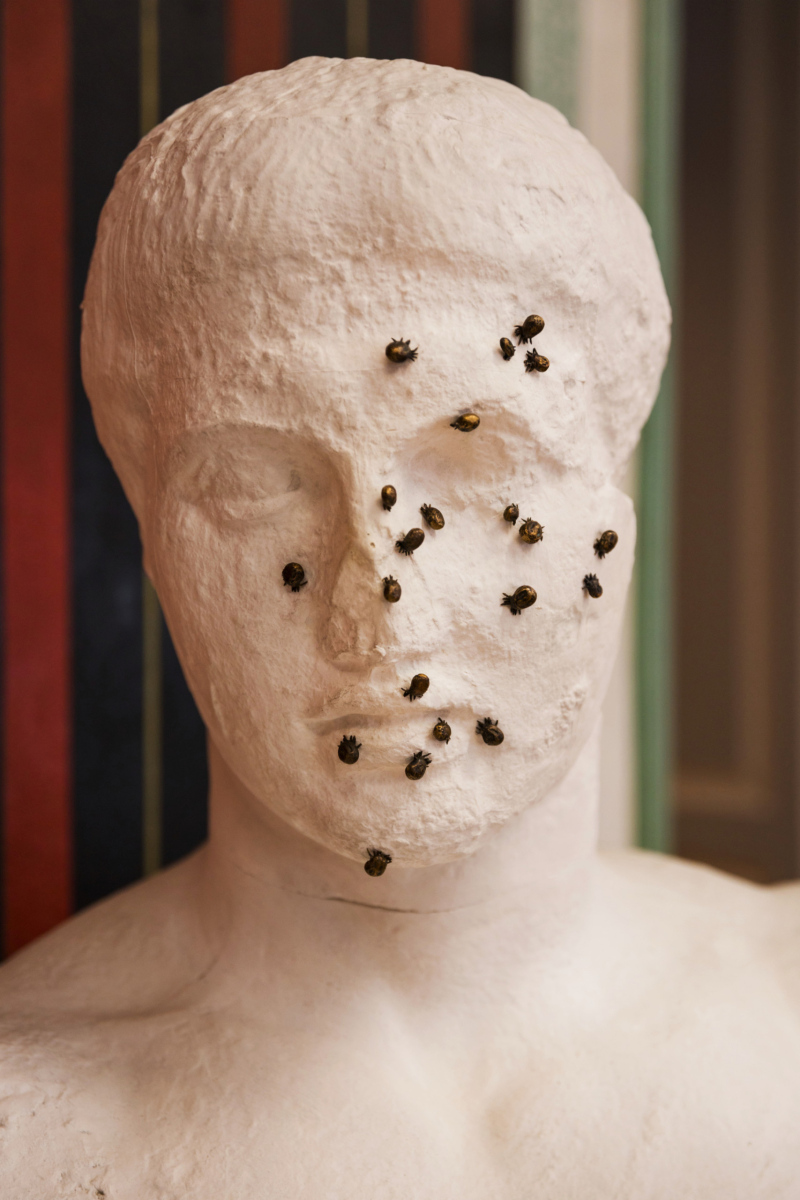SICKER duo project with Flo Kasearu at Kadriorg Art Museum, Tallinn, Estonia
Series of 100 Bronze minimonuments parasitizing on the collection of Kadriorg Art Museum.
Is the Parasite a Victim or a King?
Flo Kasearu and Elīna Vītola’s work Sicker elicits a reflection on parasites and art through the infestation of existing sculptures.
The current ecological crisis disturbs ecosystems and affects, among other things, species populations and their distribution. Whereas ticks are usual residents of Estonia, their presence has increased worldwide in the past years due to climate change, together with the number of humans affected by tick-borne diseases, namely borreliosis and encephalitis. Ticks are also at home within the Estonian scientific discourse, since they have been closely studied by Baltic-German biologist Jakob von Uexküll, who has described their Umwelt in detail. Ticks and Umwelts have made their way into contemporary art, for instance, in the video works of Eija-Liisa Ahtila or the drawings of Flaviu Rogojan. With their work Sicker, Flo Kasearu and Elīna Vītolaparasitize Kadriorg Art Museum with bronze ticks, by placing them on the museum outside columns and on some of its collection’s sculptures. Before been cast in bronze, these ticks were harvested from a family dog who unknowingly collected them on his daily walks.
This work articulates efficiently the different aspects of parasitism, both in art and in nature. As an artwork placed on other works, ticks attract attention to these existing works as much as to themselves, thus providing a new perspective on the past, reviving, in a way, works that may have “lost” their artistic power for some visitors. Like living parasites, they are interceptors who place themselves on existing relationships, in this case, the one that connects sculptures and visitors, and that provide a context to their parasitism. In this sense, Sicker’s ticks multiply art, not only by interacting with the existing works, but also by affecting the existing yet implicit viewing pact engaged with the works. Flo and Elīna’s work highlights the double-sidedness of parasites, which cannot be judged on moral terms of good and bad, despite the great damage that they can cause. In parallel to epidemics that affect humans and nonhumans alike, parasites are also to be thanked for fermented food and drink.
When reflecting on parasites through Sicker and moving away from the moral judgment that easily applies to these creatures, it is useful to go back to the various definitions of these organisms. From a biologicalperspective, parasitism designates a relationship in which one organism is harmed while the other benefits. Philosophy, however, describes parasitism as a relationship in which a host gives everything and receives nothing, whereas a parasite takes everything and gives nothing. Philosopher Michel Serres addressed the question of parasites from three angles: 1) the human one, with characters like Tartuffe, the impostor who poses as a religious devotee to take advantage of a family; 2) the nonhuman one, illustrated by the fable “The Town Mouse and the Country Mouse”, in which a town mouse invites a country mouse to feast on the leftovers of a dinner; 3) the acoustic one, which highlights noise as a type of parasite in a conversation, for example. For Serres, humans have clearly become parasites of the Earth, thus he calls for a new “natural contract” with our environment.
The parasitic situation is usually more ambiguous, and one can wonder whether the parasite is a victim or a king. Whereas the king is a parasite who relies on multiple people for his living, he can quickly turn into a victim, for the same reason that he is so dependable on numerous people. Is the tick a victim or a king? Since the tick relies on warm-blooded animals to live, it can be seen as a victim. When considering the ticks in Sicker, one could think that they are more akin to a king, living off other artworks. They raise awareness to the question of value in nature as well as in art. Since nature conservation interests and policies are more often turned toward the extrinsic value of nonhumans, based on their value for humans rather than for themselves, ticks in particular and parasites in general do not appear high on the IUCN Red List of Threatened Species, if at all. No tick is currently on that list, while 48 species of ticks out of the 900 currently known ones are threatened by extinction due to geographically restricted ranges and/or the endangerment of their specific host species.These host species may be the subject of intense conservation efforts, like the tuatara, a reptile-looking member of the order Rhynchocephalia who lives on certain islands off the New Zealand coast that have remained free of the human
introduced Polynesian rat responsible for the demise of all mainland tuatara populations. Breeding and reintroduction programs aim to increase the endangered tuatara; they may include de-ratting some islands to ensure the safety of the tuatara population. These programs, however, do not account for Amblyommasphenodonti (nor the rats!), a tick species that parasitizes only the tuatara and that is therefore extremely at risk of extinction. Who cares for the tick?
Fortunately, the tick in art attracts more consideration, although it may be disregarded by visitors who do not wish to see classical artworks parasitized. Sicker’s ticks raise not only the question of value of artworks, but also of the artists themselves and their position in society. Through their work, Flo and Elīna point to the role of the artist as an interceptor, who builds on the world to produce new objects and relationships. They remind the importance of the aesthetic experience as a renewed point of view on the world, where parasites necessitate as much attention as their hosts.
-
2023
Text by Sara Bédard-Goulet for Sirp magazine.
Article on Sirp
Curated by Reet Varblane
Photography by Bruno Habran

